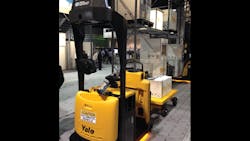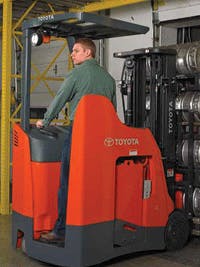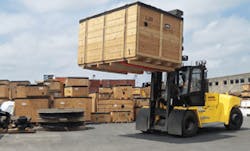When it comes to enforcing lift truck safety, the Occupational Safety and Health Administration (OSHA) has been living in the past. At least the reference document they've been using for their enforcement is. Unless OSHA takes the Industrial Truck Association's (www.indtrk.org) advice, when one of its inspectors tours your facility, if he sees something fishy regarding your lift trucks he'll check with 29 CFR §1910.178 (a)(2) and (a)(3). Those two provisions in the OSHA books reference the "American National Standard for Powered Industrial Trucks, Part II, ANSI 856.1-1969." 1969 refers to the year that version of the reference standard was updated.
Lift trucks and the safety practices surrounding them have changed a lot in the 45 years since that last revision, so by not accessing the 2012 revision of the standard, that inspector would be missing a lot.
Take high-lift order pickers, for example. These vehicles raise operators to heights that would cause certain injury or death if someone were to fall from them. Yet the following is all the 45-year-old reference standard says about high-lift order picker truck safety: "Operator platform should be equipped with guard rails or means for securing an operator tether."
The latest version of the standard adds quite a bit more guidance on safety in such situations, including guard rail height, the force that guard rail should be able to withstand, and the elements of a fall protection system, including a body belt. It even describes the purpose of a personal fall protection system: "to limit the distance an operator can fall from the platform and limit the forces imposed on an operator's body when the fall is arrested. Personal fall protection system configurations are based on the operator's weight." To top all that off, there's a table illustrating fall protection system configurations.
Forklift Safety DayIs depriving inspectors of such detail a problem? The ITA thinks it's more of an opportunity. That's why in a letter dated May 6, 2014, ITA president Brian Feehan told William Perry, acting director of the directorate of standards and guidance at OSHA, that updating the reference would give the standard "greater visibility and would help to promote it in the minds of employers, employees, state safety and health officials, private-sector safety professionals and the public." He added that it would clear-up the ambiguity arising from the fact that certain states and foreign authorities already reference post-1969 versions of the standards. Adopting the 2012 version would "put OSHA in the position of leading rather than following," Feehan concluded.
This dialog eventually led to an idea. Why not devote a day to forklift safety so all law makers in Washington can understand how operator training in particular and forklift safety overall contribute to the health of American industry?
That day has been officially designated National Forklift Safety Day, and will be June 10th this year and on the second Tuesday of June in succeeding years. Sponsored by the Industrial Truck Association, with MH&L as the exclusive media sponsor this year, the event will spotlight the safe use of forklifts and the importance of operator training. OEMs will deliver this message in person, not only to end users but to policymakers and power brokers.
Users Taking the Lead
Leaders among the lift truck user community are already leading by example where forklift safety is concerned. For example, Tom Pettit, vice president and general manager of supply chain solutions for 3PL service provider Ryder Systems (www.ryder.com), tells his employees that speed and productivity aren't synonymous. And where forklifts are concerned, they play an important role in helping management promote safety as one of their company's core values.
"We can improve speed not by operating a forklift faster, or by increasing the rating; in fact when we did an acquisition we actually de-rated some of the forklifts in some of our buildings because of safety concerns," he says. "But we then have to take out other waste, like reducing the transportation distance in the warehouse by better warehouse design, by better slotting, or by improved replenishment. We embrace lean enterprise techniques. We use process improvement techniques to identify waste and remove it. Speed is about finding and eliminating the waste, not necessarily doing an activity faster."
A Culture of Training
Making safety a corporate value isn't enough. Neither is relying on OSHA to inspect safety into an operation. People should take personal responsibility for safety and become part of the training process. Jay Costello, director of training for Yale Materials Handling Corporation (www.yale.com), says OSHA is not very prescriptive in their guidelines for how forklift safety training gets done.
"OSHA does not require that operator instructors be certified; only that they have the ‘knowledge, training and experience' to train powered industrial truck operators and evaluate their competence," he observes. "Since every potential operator, including part-time, seasonal and substitute workers, must be trained at least every three years, using veteran operators to assist with training is a great way of creating a stable group of instructors at the ready."
Costello says Yale agrees with ITA that OSHA should reference the newer standard to take advantage of its design and technology enhancements, but ultimately, safety comes naturally out of a company's culture, and training is just another form of communication.
"Aside from emphasizing safety, clearly communicating the contribution employees can make is one of the most powerful ways of making training more important and valuable in the minds of all employees," he says.
Kevin Krakora, director of product services at Mitsubishi Caterpillar Forklift America (www.mcfa.com), says both new and veteran operators could learn from each other in a properly structured training program. New operators are usually eager to learn, and although they have no experience with the equipment, they don't have the bad habits that some veteran operators might have. Those veterans, on the other hand, have seen their share of incidents or near misses and could benefit a training class that is mixed with new and veteran operators by speaking about those experiences.
"Whether using a vehicle with new or old technology, the operator is still ultimately responsible for safety," Krakora says. "Through daily checks, they need to be aware of whether technology systems are working correctly, and they need to understand which type of vehicle they are on."
Maintenance Supports Safety
There are fine details about their forklifts that even the most experienced operators might miss—which is why regular preventative maintenance is so important. This kind of maintenance requires a technician's eye, says Mark Faiman, product manager, IC, AWP, and GSE products for Toyota Material Handling (www.toyotaforklift.com).
"An important part of a regular preventative maintenance program is for the technician to inspect the complete truck," he says. "That technician will note items that may not be noticed by others. Items such as damaged lights, defeated safety systems like seat belts, impact damage, exhaust leaks, worn hoses and chains, etc., will be spotted by a technician during a PM service. Plus, using a technician will show documentation that an owner is properly maintaining the equipment in case it is requested due to an accident. It is one of the best preventative measures an owner can take."
What Telemetry Tools Tell
The technician's eye, combined with the sensors on many of today's lift trucks, can tell a complete story of a lift truck and its operators, explaining not only the what, but the why and when, says Brett Schemerhorn, vice president of marketing for Hyster Company (www.hyster.com).
"Telemetry provides the ability to monitor performance (impacts, drive speed, equipment inspections) and to identify and pre-emptively address inappropriate behaviors, which ultimately can help to prevent problems," he says. "Having data related to impacts and incidents readily on hand will also allow companies to better isolate and work on remediating problem areas or situations."
Such reports can take the form of an operator report card, suggests Scott Craver, product manager for business and information solutions at The Raymond Corporation (www.raymondcorp.com). "Drivers who have the most active time with the least number of impacts per activity time are the ones who should be rewarded with incentives," he adds.
"Systems which integrate fleet and labor management data can automatically e-mail such reports on a pre-scheduled basis—with no action required to run the reports."
Carrot or Stick?Remediation can be positive or negative, and ultimately the supervisor is the best judge of which would be more effective on a particular operator. But regular reinforcement of good behavior can preclude the need for remediation, and a behavior-based safety recognition program can be an effective way to recognize operators working productively and safely, according to Ron Brewer, manager of operator training for Crown Equipment (www.crown.com).
"Sometimes all it takes is a simple ‘thank you,' or ‘good job' to reinforce and incentivize the desired behavior," he says.
That's fine coming from a supervisor, but it can be even more powerful coming from the CEO or other high-ranking executive. Brewer recommends that while that executive is in the operator's environment they also assess how the supervisor reinforces productivity and whether safety is ever compromised by that reinforcement. Use the following checklist:
- Do operators feel compelled to load or unload a trailer that has a broken dock lock?
- Do they feel punished if they refuse to unload it?
- Do they feel pressured to operate a truck with a non-working horn or with inadequately performing brakes?
- Do they feel valued when they find and report these problems and tag-out equipment until repaired?
"Experience shows that rewards work," Brewer says. "And for operators to work as part of your safety program, you need to make sure your workplace rewards are in line with your safety goals to create the best environment for productivity."
In the end, safety's worst enemy is apathy. Driving a forklift can become routine, and no matter how much technology you throw at the situation, the operator should represent your biggest investment—of your time.
"Backup alarms, flashers and other accessories are all good, but you can eventually end up with a situation where the operator gets used to them, gets apathetic and suddenly you have an accident," concludes Dave Nicolette, technical trainer for Clark Material Handling (www.clarkmhc.com). "You can't depend on safety devices."
One occupational safety rule has remained constant since the forklift was invented and never needs updating: safety's best friend is an engaged operator.
About the Author
Tom Andel
Editor-in-Chief
Tom Andel is an award-winning editorial content creator and manager with more than 35 years of industry experience. His writing spans several industrial disciplines, including power transmission, industrial controls, material handling & logistics, and supply chain management.



